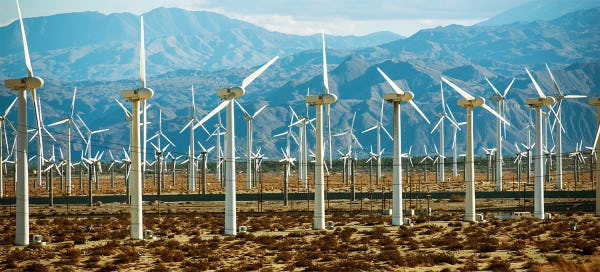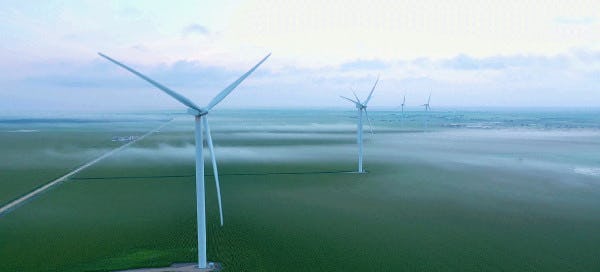The Rise of Texas Wind Farms: Benefiting from Local Wind Energy
Ahhh, the joy that a fresh, cool breeze can bring to the hot Texas months… We know it well! But wind does much more than help our residents beat the summer heat, it also helps power our homes and businesses with clean, renewable energy that boosts our economy. Read on to learn everything you want to know about wind energy – an important part of our renewable energy strategy here at Rhythm Energy.
History and Growth of Wind Energy in Texas
Although windmills have been used since ancient times for pumping water and grinding grain, the first modern wind turbine was designed and constructed way back in 1887, by a Scottish engineer named James Blyth. By the 1930s, turbines were popular for generating electricity across Europe, North America, and Australia, mostly on farms and in remote locations without easy access to the power grid.
Fast forward to today, when Texas is the undisputed leader of generating wind energy in the United States, thanks to our abundant wide-open spaces and ideal wind conditions. By early 2021, Texas had more than 15,000 big turbines active in our state, and the year following generated more than 40,000 megawatts – accounting for more than 26% of all wind energy in the country.

How Wind Turbines Work
To understand how turbines operate, think of an enormous electric fan that works in reverse. Instead of drawing electricity to spin the blades, they are rotated by naturally occurring wind, which operates a turbine that generates electric power. This energy is now less expensive to generate than power from any other resource, including coal plants.
Environmental Benefits of Texas Wind Energy
The combination of wind and solar energy is helping Texas create a more stable and environmentally friendly grid. Not only do turbines not pollute the air or water, they lead to a reduction in the amount of greenhouse gasses produced by generating power, since wind energy releases no carbon emissions. In fact, wind energy produces about 11 grams of carbon dioxide per kilowatt hour, compared to 9800 grams for coal and 465 for natural gas.
Wind turbines also require a relatively small footprint, compared to power plants. They can be placed on open land, mountain ridges, abandoned or underused industrial sites, offshore in the Gulf – even on agricultural land, without displacing or disrupting crop growth.
Economic Impact of Texas Wind Farms
The expansion of wind energy generation in Texas has been a boon for many local communities, creating jobs in the energy sector as well as construction, engineering, and manufacturing. In 2022, there were 26,135 wind power jobs in the state, with an average annual wage of $109,826.
Wind farms also generate tax revenue for local governments. For example, the Roscoe Wind Complex, the state’s second largest wind farm, is spread across 100,000 acres and four counties. Its 627 wind turbines not only can power 194,000 homes, they have also remitted more than $92 million in local taxes since 2008.
Key Wind Farm Locations in Texas
The top three wind farms in the state, by power generation, are:
Los Vientos Wind Farm: 426 turbines generating 912 megawatts in Starr and Willacy Counties
Roscoe Wind Farm: 627 turbines generating 781.5 megawatts in Roscoe County
Horse Hollow Wind Energy Center: 421 turbines generating 735.5 megawatts in Taylor and Nolan Counties.
The High Plains region, including the Texas Panhandle and West Texas, has more than 11,000 turbines operating in the area, providing up to 20% of the energy used by Texans in 2019.
Challenges and Solutions for Wind Energy
One of the biggest challenges to maximizing the benefit of renewable energy is providing adequate storage for the energy that is created, so power is available even when the wind isn’t blowing or the sun isn’t shining. These storage solutions, including batteries, thermal storage, and other options, are critical for providing dependable energy during periods of peak demand.
Another challenge has to do with transmission capacity: building power lines to transport the energy generated by wind and solar sources to customers. These can take up to ten years to construct and require a significant investment of capital. Texas is investing in new transmission lines, as well as updating existing ones to work with new technologies.
A third challenge is regulatory, which Texas is working to overcome through a combination of policies and technology advances. Established in 1999, the Renewable Portfolio Standard has set targets for renewable energy generation and served as a key driver of its development. There are also federal tax incentives, specifically the Production Tax Credit and Investment Tax Credit, which make wind farms more financially attainable. And new technologies have improved forecasting, allowing the Electric Reliability Council of Texas (ERCOT) to predict how much wind power will be available even before it is generated.
Other Technological Advancements in Wind Energy
Other technological innovations and advancements have also helped. Wind turbines have taller towers and larger blades than in years past, allowing them to be more efficient and effective. Also, the creation of hybrid energy systems, integrating wind and solar with battery storage, has come a long way, as have the use of artificial intelligence and machine learning to optimize turbine performance and enable predictive maintenance.
Future Outlook for Texas Wind Energy
According to the U.S. Bureau of Labor Statistics, the wind energy industry is expected to have a lot of job security over the coming decade, with predicted growth of 44% by 2031. In fact, the Department of Energy’s Wind Vision Report states that wind has the potential to support over 600,000 jobs nationwide in manufacturing, maintenance, and support services by the year 2050. And after securing $6,2 billion in federal tax incentives and grants in 2023, the Lone Star State is well-situated to maintain its place as America’s leader in emerging energy technologies.
At Rhythm Energy, We’re in on Wind
We’re committed to bringing our state 100% renewable energy – from wind, solar, and hydro – at affordable prices and with excellent customer service. We offer a variety of plans, including ones powered solely by wind energy. To find out what is available in your service area, visit gotrhythm.com and enter your zip code.
FAQs
How do wind farms work and how reliable are they?
Wind turbines generate power when naturally occurring wind rotates their fans, producing electricity. They are extremely reliable in a location such as the open plains or Gulf waters of our state, especially when combined with batteries or other means of storing power.
What are the environmental benefits of wind energy?
Wind power doesn’t create carbon emissions or otherwise pollute the air (or water). And because wind is a renewable resource, it doesn’t require the use of fossil fuels to generate electricity.
How can I benefit from local wind farms?
If you’re looking for a job, then look to the wind industry! Its employment growth is strong, and predicted to get even stronger in the coming years. You might also benefit from taxes pumped into the local economy by wind farms.
Are there any cost savings associated with wind energy plans?
At Rhythm Energy, we’re committed to bringing you energy plans that are not only 100% renewable, they are also affordable. Go to gotrhythm.com to find out what’s available in your service area.




